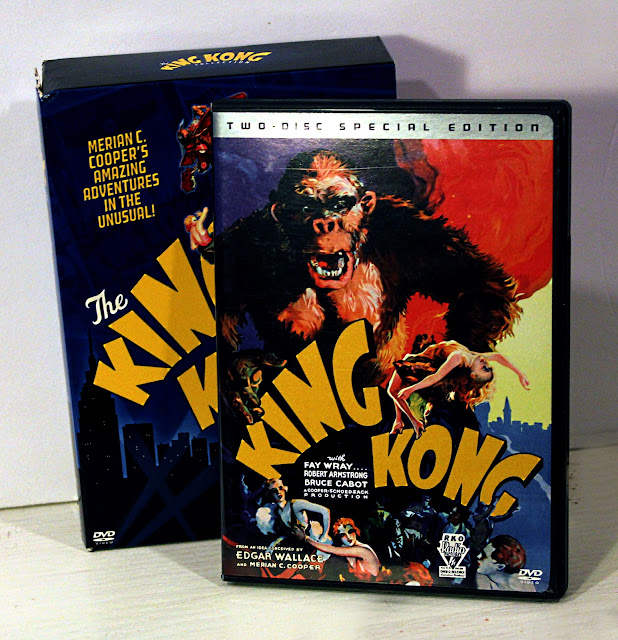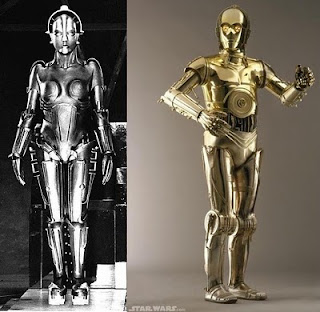KING KONG (1933)
After watching the last episode of The Book of Boba Fett and seeing the rancor climb the tallest building in Mos Espa, I texted our guest writer Phil Congleton and asked, “Can you write about King Kong next month?” Well, here is it….
 |
| Photo by Phil Congleton |
King Kong (1933)
One of the most remembered images, that most people think of, when the subject of the original King Kong (1933), comes up, is Kong standing on top of the Empire State Building, clutching Ann Darrow (Faye Wray), in his powerful hand. So, when the film came out in theaters, it made total sense to debut the film in New York City. March was the month that Kong made his world debut. It premiered in New York City on March 2nd, 1933, at Radio City Music Hall. Thirteen days later it premiered in Baltimore, Maryland and 21 days later it debuted in Los Angeles at Grauman's Chinese Theatre for its official Hollywood debut. The television version was released 23 years later on March 5th, 1956. We will talk about this later on.
Remember back, a decade ago, when Avengers (2012), hit theaters and everyone wanted to see what the spectacle was all about? Now, put yourself in a 1933 frame-of-mind and check out what it was like to be amazed and terrified at the theaters in the early 1930s. Kong had that same effect on a 1933 audience that Avengers (2012), did today. Billed as the "8th Wonder of the World", Kong lived up to the publicity. It too exploited the technical achievements of the time, but, there was even more to the film than just professionally styled stop-motion photography.
Kong was broken up into three different acts. The trip on the ocean, Skull Island, with the coming of Kong and the third act, which takes us back to New York City. It's a wonderfully, pieced-together story. A story that works, so that the audience can concentrate more on the technical spectacle that the film was. It's an off-shoot of the beauty and the beast concept. An idea promoted often by the man in charge of the expedition, movie director/producer Carl Denham (Robert Armstrong). It is his character that spearheads all the plot arcs and the direction the film goes. He starts the film off and he ends it. It is his character that draws everyone and everything into the story.
Denham needs to finish his movie, but he needs a new face to help him with his big discovery. He finds a starving actress, Ann Darrow (Fay Wray), rents a cargo ship, with a crew and heads off into the Atlantic, in search of the isolated island. It is here were we get to meet the characters and learn more about the expedition. Once we get to the island, meet the natives and meet the King himself, this is when the technical part of the movie really kicks in. Special effects forefather, Willis O'Brien, first got the itch for Kong after he worked on the Lost World (1925). From there, sound was invented and the next thing he wanted to tackle was a film like this. His unique brand of artistry was noticed by other filmmakers of the time.
Director, Merian C. Cooper, took one of O'Brien's unfinished film scripts and along with co-director, Ernest B. Schoedsack, fashioned out a tale, that created a legendary character. A character, that is still a box office draw at movie theaters today Godzilla vs Kong (2021). He even made the Empire State Building more popular. If you are not a fan of these kinds of films, what you can enjoy the most out of this one, is the highlighted, stop-motion effects. To fully appreciate this film, you need to consider the process it took to make this film and animate these cinematic monsters.
True, they are models, but it takes a lot of skill, artistic talent and time to make them. After that, you need to shoot them moving one frame at a time. You take a picture, then move the arm or leg a 1/4 of an inch, then take it again. It is a very time consuming, stressful and possibly, irritating process, to get all this shot, to the point, that they look like real, moving creatures. It is very grueling work, with hopefully huge results. This film has everything. You need to see why Kong is the "8th Wonder of the World". Also, Composer, Max Steiner's trumpets and horns jack up the energy level to an amazing height.
8.9 (A- MyGrade) = 9 IMDB, 4 1/2 Stars Letterboxd
The Star Wars Connection
It's not a secret, that in recent years, some have expressed an idea that George Lucas was inspired by the classic film King Kong (1933), especially when talking about Return of the Jedi (1983). The section, in particular, that is addressed, happens in the beginning of the film, when Luke is trapped in Jabba the Hutt's dungeon, with a giant creature called a Rancor. Also, trapped in the pit with Luke, is a Gamorrean creature, who fell in the pit with him. Whenever I think about that scene in ROTJ, the first thing that comes to my mind is the shot of the Rancor stepping on and chewing on the Gamorrean. It completely takes me back to Kong stepping on and chewing on various island natives, during his breakout through the Skull Island wall. It's easy to compare and probably did happen, but there are other interesting factors afoot that makes this an intriguing situation to explore.
When King Kong was released in theaters in 1933, it was situated during the transition period between the pre-code era and the post-censorship code era of motion pictures. It was originally 104 minutes long in 1933, but as the censors worked on it over the decades, it had been reduced to 100 minutes, with many scenes or shots removed for post-code audiences. This would be the version of the film people would see the most, during the time from the 1940s to the 1970s. It was trimmed a little bit more for its television debut in 1956, below 100 minutes. Anyway, the film went through a drastic change, shortly after its original release and for a long time, this was the version shown in theater re-releases, television and for a time, VHS. Finally, an intact version of the 100 minute film was found in 1969, making a few appearances at film festivals, arthouses and theater re-releases. A couple other versions were found over the years. It finally was available for home video use by the mid-1980s, with the original four minute overture added in 2005, bringing it back to the 104 minutes, that it originally was back in 1933. I remember finally seeing the restored scenes myself in the late-80s on a VHS copy I had.
So, the scenes I mentioned above, depicting Kong stomping and chewing Skull Island natives, was lost for consumer consumption until, almost 1983, fifty years after Kong came out. George Lucas was born in 1944, so the version he saw as a kid was the trimmed, post-code, version of the film. We all know Mr. Lucas has some pull in the film business, so it's always possible he acquired a copy of the Kong missing footage in the 1970s. That is only if he even knew about it being available at arthouses or he heard about it and used his pull to acquire a copy of it, because consumer use for this film at home wasn't really available until after the release of ROTJ. It is quite possible they were influenced by Kong's restored scenes, as late as 1983, while doing the finishing up work on ROTJ's post-production.
Another huge nod from the Star Wars universe to King Kong (1933), is the game Dejarik, that Chewbacca and C-3PO play in Star Wars (1977). You know the one I mean? It's the futuristic chess game, seen on the Millennium Falcon, with small holographic creatures moving about the board. Chewbacca threatens to remove C-3PO's arm if he doesn't let the Wookie win. It is not so much an homage to Kong, as it is to the stop-motion effects used to create the game. It looks every bit like the figures are moving, much like Kong and the dinosaurs found on his Island. It also was influenced a lot by the work of Ray Harreyhausen, who was the king of stop-motion effects from the 1950s-1980s. What is really cool is stop-motion photography was dead by the 1990s, but the creators of the new Star Wars trilogy, brought the game back in for Star Wars: The Force Awakens (2015). Being back on the Millenium Falcon, with Chewbacca, was the perfect time to bring the game back out. The filmmakers felt the need to feature the game again. The special effects crew kept the figures on the board, at the same special effects style seen in the original Star Wars (1977). It was totally an homage to stop motion photography from old Hollywood. Getting back to the Rancor creature from Return of the Jedi (1983), the creators of the new Star Wars TV show, The Book of Boba Fett (2022), brought the creature back for some excellent King Kong style action. He even climbs up a building. Cool stuff.
About the Author
Phil Congleton is a lifelong, but retired, film buff, who worked in television for 30 years and produced some small independent films in the 1990s. He just loves the art of film. You can read more of Phil's film reviews on Letterboxd.


Great entry! I grew up in the NYC area and remember watching King Kong every Christmas on WPIX. I honestly believe that watching this film cultivated my love of classic film from the age of 4!
ReplyDeleteWhat a great tradition! Thanks for sharing and commenting on our post. :-)
Delete